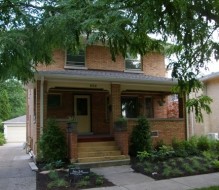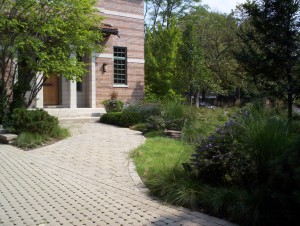Join us on September 28th for a day of discovering the thriving, resilient, sustainable community we have in Oak Park and River Forest! The 2013 Green Living and Learning Tour will consist of 18 sites including nine one-hour tours and nine drop-in opportunities, all scheduled between noon and 5:00pm. Learn more about each of the nine one-hour tours below. See information about drop-in opportunities and get a printable PDF of the tour schedule here. A tour map will be posted soon.
River Forest Passive House
 1430 Jackson Ave, River Forest
Site #1 on map
Tour at 1:00 pm
Passive House, Healthy Home – This first-of-a-kind home for Chicagoland sets a high bar for energy efficiency and indoor health: it is the first Certified Passive House in the Chicago region (28th in nation), and the second DOE Challenge Home in Illinois (one of first 20 in nation). Passive House is the most stringent building energy efficiency standard in the world; it requires that the envelope of the home is designed to minimize losses and maximize passive gains, with careful attention to building science and indoor air quality. The result is a super comfortable home with minimal operating costs, great indoor air quality, and far less maintenance requirements than a typical home.
1430 Jackson Ave, River Forest
Site #1 on map
Tour at 1:00 pm
Passive House, Healthy Home – This first-of-a-kind home for Chicagoland sets a high bar for energy efficiency and indoor health: it is the first Certified Passive House in the Chicago region (28th in nation), and the second DOE Challenge Home in Illinois (one of first 20 in nation). Passive House is the most stringent building energy efficiency standard in the world; it requires that the envelope of the home is designed to minimize losses and maximize passive gains, with careful attention to building science and indoor air quality. The result is a super comfortable home with minimal operating costs, great indoor air quality, and far less maintenance requirements than a typical home.
Certified Wildlife Habitat
 1165 S Wenonah, Oak Park
Site #2 on map
Tour at 1:00 pm
1165 S Wenonah, Oak Park
Site #2 on map
Tour at 1:00 pm
This yard is certified by the National Wildlife Federation as a Wildlife Habitat The yard has mostly native plants and uses multiple water management techniques including downspouts disconnected from the sewer system, rain barrels, and swales to ensure that the homeowner almost never needs to run fresh water for the plants. New plants are helped through the first year with soaker hoses on timers and Plant Nannys. After that they survive on their own, even in our current late summer drought. The yard is also designed to provide shade in the summer and sunlight on the house in the winter.
Zero% Rainwater Runoff!
 630 N. Marion St., Oak Park
Site #3 on map
Tour at 1:00 pm
The goal for this house was threefold: a) eliminate rainwater runoff so it could all be used or absorbed on the property; b) store plenty of rainwater to help with watering the raised-bed garden; and c) store rainwater to be used to irrigate a green roof that was part of an architectural remodel. GREENheart Buildings Inc., in coordination with Nathan Wright Landscape Design, developed a system to meet th0se goals.
630 N. Marion St., Oak Park
Site #3 on map
Tour at 1:00 pm
The goal for this house was threefold: a) eliminate rainwater runoff so it could all be used or absorbed on the property; b) store plenty of rainwater to help with watering the raised-bed garden; and c) store rainwater to be used to irrigate a green roof that was part of an architectural remodel. GREENheart Buildings Inc., in coordination with Nathan Wright Landscape Design, developed a system to meet th0se goals.
The system uses two 4-unit arrays of Rainwater Hog storage units, an actively-pumped green roof watering system and a gravity-feed passive drip irrigation system, as well as multiple french drains to redirect and absorb any excess flow. One of the storage arrays is concealed below the rear deck, and the other is behind the garage. The system has debris screen units that also act as winter bypasses to direct the roof flow around the storage units during freezing weather.
.
Green by Design
 807 Forest Ave, River Forest
Site #4 on map
Tour at 2:30 pm
807 Forest Ave, River Forest
Site #4 on map
Tour at 2:30 pm
Ecological principles were designed and built into this home from the beginning, including: renewable energy, energy efficiency, water and resource conservation, and toxic free materials. Water conservation features include rainwater catchment for irrigation, native landscaping, permeable driveway and water-saving faucets and showerheads. The home is kept warm in the winter and cool in the summer through south-facing exposure, deep window well design, geothermal heating and cooling, effective insulation, and radiant heat in the basement and garage.
White Roof & Tankless Hot Water Heater
 214 S. Elmwood Ave, Oak Park
Site #5 on map
Tour at 2:30 pm
214 S. Elmwood Ave, Oak Park
Site #5 on map
Tour at 2:30 pm
40-year residents, living in an Oak Park historic district, the Robinets, are showing their environmental stewardship in lots of different ways. Over the past six years they have installed an energy-efficient metal white roof, skylights, a tank-less hot water heater, and insulation in the walls. Last year they also installed a geothermal heating and cooling system which will reduce carbon dioxide put into the air by a quarter of a million pounds over the next 50 years.
Eco-conscious Home, a Joint Effort of Local Experts
 634 Clinton Ave, Oak Park
Site #6 on map
Tour at 2:30pm
634 Clinton Ave, Oak Park
Site #6 on map
Tour at 2:30pm
Welcome to our house! When we first decided to deconstruct an old home in Oak Park and build a new larger one, we began to research our options for eco-conscious building. One thing we are proud of is that the building of our home was very much a local effort from an amazing team of experts. At the time geothermal was something more done in Europe than the US and when the Village of Oak Park was just beginning to understand how to process solar permits. And now, as to date, our SunPower monitoring system says we have produced 12, 286 kWh…reducing emissions equivalent to not driving 20, 191 miles in a standard car or planting 226 seedlings grown for 10 years. We are happy that now many of the features and materials we have in our home are now common practice and people renovating even the smallest of home projects have many great options. Please enjoy the tour.
Grey Matters
 165 N. Taylor Ave., Oak Park
Site #7 on map
Tour at 4:00 pm
165 N. Taylor Ave., Oak Park
Site #7 on map
Tour at 4:00 pm
This 94-year old, LEED-registered home in Oak Park’s Ridgeland Historic District underwent a deconstruction and gut rehab. The project won a 2012 Green Award from the Village of Oak Park and aimed to incorporate green innovations for energy/resource conservation, while preserving the character of the original Prairie-style, The home utilizes a renewal geothermal energy system for HVAC and domestic hot water. It includes one of the first residential greywater systems in IL, anticipated save 20-30% on indoor water use by recycling water from tubs/showers into toilets.
Frank Lloyd Wright Home with Geothermal
 534 N East Ave, Oak Park
Site #8 on map
Tour at 4:00 pm
534 N East Ave, Oak Park
Site #8 on map
Tour at 4:00 pm
We've slowly learned, and sought out, ways to restore the house which respect its history but also incorporate 21st century efficiency technology. In 2005 we were exploring upgrading the heating system both to replace the inefficient old boiler as well as remove the first floor radiators which compromised historic restoration. I began to educate myself about optimizing the efficiency of hot water heat. This led to under-floor radiant on the first floor and the basement floor. These changes required the services of a local mechanical engineer who was experienced in and a fan of ground source (“geo-thermal”) heat pumps. We've experienced a gradual but consistent reduction in energy consumption over the period 2006-2013, even though we significantly enlarged the square feet of space now within the conditioned thermal envelope.
Save $$$, Increase Comfort, Decrease Carbon Footprint
 616 Wenonah, Oak Park
Site #9 on Map
Tour at 4:00pm
616 Wenonah, Oak Park
Site #9 on Map
Tour at 4:00pm
The Environmentalist's Dilemma: Is it possible to keep your home warm in winter and cool in summer without doing a whole lot of damage to the environment? It is, and what's best, it's possible to do it on a reasonable budget. After sealing and insulating their house, the homeowners had the warmest winter in their home in 15 years and their energy bills were lower than they had ever been. Learn about air sealing and insulating and the fantastic rebates available to help make a more comfortable, environmentally friendly, (and valuable) home a reality. The Bonus: See a blower door test in action: a diagnostic tool designed to measure the air-tightness of buildings. and to help locate air leakage sites.
